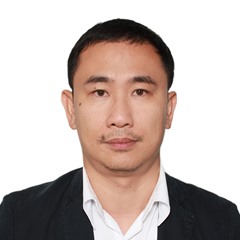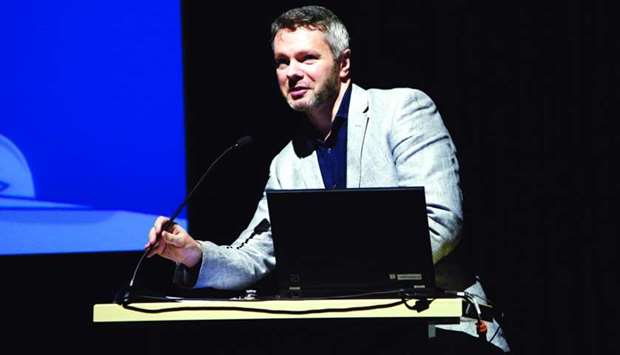*The national museum’s digital library contains the intangible heritage of Qatar – from poetry to music, oral histories and photographs
Students from various schools in the country stand to benefit from the diverse range of learning programmes at the soon-to-open National Museum of Qatar (NMoQ).
Speaking at the recently-held Teachers Council, NMoQ’s Learning and Outreach associate director Dr Alan Michael Kirwan said they prepared a curated programme for students aimed at raising their curiosity and interest.
“For me, museum education is about raising curiosity, which then leads to creativity. We try to get a layered experience for you (teachers) and your students so we give you different options, it is like a pick and mix that you can choose what suit you,” he said.
NMoQ, set to showcase an impressive array of archaeological and heritage objects, including the renowned ‘Pearl Carpet of Baroda,’ will offer four specific types of school tours at the ‘foundational level’ supervised by museum educators.
First is the 90-minute NMoQ Overview, which provides a sense of the museum content while the Highlights Tour brings students to key installations and objects in the galleries.
The Green Tour will feature the gardens outside the museum, consisting an array of plants and nature species from different parts of the world.
“It talks about this global links that the museum will really try to emphasise,” Dr Kirwan said.
Fourth is the Public Art Tour, which focuses on public art pieces both inside and outside the museum by contemporary artists.
Students can also take part in the national museum’s in-depth and interactive Discovery Programme, allowing participants to choose from its 10 options. It includes Precious Plants, Amazing Animals, Lulu (meaning pearl in Arabic) Hunt, and the Design Future – all part of a ‘structured and streamlined procedure’ from orientation to creative workshops.
“The discovery booklets are full of find-and-search activities such as puzzles and games, sketching activities, it is made in an interactive fun way for children,” Dr Kirwan said.
Among NMoQ’s key educational resources are ‘learning trolleys,’ he noted. They hold real and replica handling collections – objects that make up science, daily life, and customs and heritage, among others. These trolleys can also be brought to schools if requested.
The national museum’s innovative educational programmes go beyond learning studios or workshops and extend to family exhibit spaces such as the Discovery Zone, located in its galleries, according to Dr Kirwan.
Young visitors can also play in interactive screens with the informational content, and the ‘put back together objects’ game.
“It is very creative, hands-on, and actually very colourful, children want to engage all their senses, and these spaces can do that for them,” Dr Kirwan said.
“Outdoors, what we’ll have are much more than a playground, very interactive spaces where children can go during the winter months and the focus is learning through play,” he added.
Besides its impressive collections and items in the galleries, the museum will also have its own library, comprising several books about Qatar’s culture and heritage.
Bespoke research areas, quite zones, and computers to access information are some of the library’s feature, apart from having book circles, meet the author or script writer, among other similar activities.
“Our digital library is just as important as the physical, it contains that intangible heritage of Qatar – from poetry to music, oral histories and photographs are all that contained in this site,” Dr Kirwan said.
About the museum’s other plans, he said a team of incoming artists who come from different disciplines and backgrounds will also be joining NMoQ in a few weeks.
“We need artists to bring our programmes to life and they bring that creative spark to things. On freelance capacity, we ‘ll also be joined by actors and storytellers to deliver certain initiatives,” Dr Kirwan added.
Speaking at the recently-held Teachers Council, NMoQ’s Learning and Outreach associate director Dr Alan Michael Kirwan said they prepared a curated programme for students aimed at raising their curiosity and interest.
“For me, museum education is about raising curiosity, which then leads to creativity. We try to get a layered experience for you (teachers) and your students so we give you different options, it is like a pick and mix that you can choose what suit you,” he said.
NMoQ, set to showcase an impressive array of archaeological and heritage objects, including the renowned ‘Pearl Carpet of Baroda,’ will offer four specific types of school tours at the ‘foundational level’ supervised by museum educators.
First is the 90-minute NMoQ Overview, which provides a sense of the museum content while the Highlights Tour brings students to key installations and objects in the galleries.
The Green Tour will feature the gardens outside the museum, consisting an array of plants and nature species from different parts of the world.
“It talks about this global links that the museum will really try to emphasise,” Dr Kirwan said.
Fourth is the Public Art Tour, which focuses on public art pieces both inside and outside the museum by contemporary artists.
Students can also take part in the national museum’s in-depth and interactive Discovery Programme, allowing participants to choose from its 10 options. It includes Precious Plants, Amazing Animals, Lulu (meaning pearl in Arabic) Hunt, and the Design Future – all part of a ‘structured and streamlined procedure’ from orientation to creative workshops.
“The discovery booklets are full of find-and-search activities such as puzzles and games, sketching activities, it is made in an interactive fun way for children,” Dr Kirwan said.
Among NMoQ’s key educational resources are ‘learning trolleys,’ he noted. They hold real and replica handling collections – objects that make up science, daily life, and customs and heritage, among others. These trolleys can also be brought to schools if requested.
The national museum’s innovative educational programmes go beyond learning studios or workshops and extend to family exhibit spaces such as the Discovery Zone, located in its galleries, according to Dr Kirwan.
Young visitors can also play in interactive screens with the informational content, and the ‘put back together objects’ game.
“It is very creative, hands-on, and actually very colourful, children want to engage all their senses, and these spaces can do that for them,” Dr Kirwan said.
“Outdoors, what we’ll have are much more than a playground, very interactive spaces where children can go during the winter months and the focus is learning through play,” he added.
Besides its impressive collections and items in the galleries, the museum will also have its own library, comprising several books about Qatar’s culture and heritage.
Bespoke research areas, quite zones, and computers to access information are some of the library’s feature, apart from having book circles, meet the author or script writer, among other similar activities.
“Our digital library is just as important as the physical, it contains that intangible heritage of Qatar – from poetry to music, oral histories and photographs are all that contained in this site,” Dr Kirwan said.
About the museum’s other plans, he said a team of incoming artists who come from different disciplines and backgrounds will also be joining NMoQ in a few weeks.
“We need artists to bring our programmes to life and they bring that creative spark to things. On freelance capacity, we ‘ll also be joined by actors and storytellers to deliver certain initiatives,” Dr Kirwan added.




